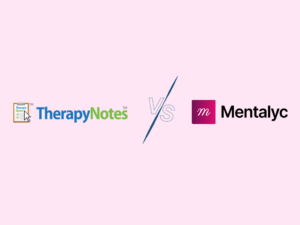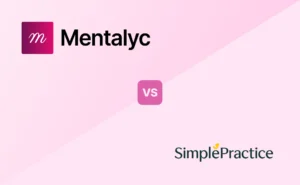How to Write DAP Notes
There are a variety of methods therapists can use to write progress notes. With various ways to document client sessions, mental health professionals may have difficulty choosing which documentation format to use.
DAP notes have three clearly defined sections, which help therapists cover the necessary information in their therapy progress notes while also being brief. A benefit to mental health professionals is that DAP notes don’t take up much time. If you find it challenging to choose a note format, you may consider the DAP progress note. These counselling notes are easily readable and divided into sections so those accessing documentation can follow along.
What is a DAP note?
The acronym “DAP” stands for Data, Assessment, and Plan, the three sections included in a DAP note. This format is a structured way of formatting your notes and can help you save time. This method differs from other note formats, such as SOAP or BIRP notes. Many clinicians choose to use DAP notes for their ease of structure.
What are the benefits of DAP notes?
DAP notes don’t take long and include the information insurance companies require. In addition, they offer a structured format and build off of each existing section. The DAP note template lets you track client progress easily since you can view each part of your notes from the last session and note any changes in the client’s symptoms or progress quickly.

New! Transfer your notes to EHR with a single click. No more copy-pasting.
How long should a DAP note be?
A DAP note’s length will depend on each client you see and what you’re working on in the session. There is no required length for a DAP note; each note’s length may change depending on the client’s progress and how many changes there are in the client’s treatment plan.
For example, if your client is progressing well, your documentation may be of similar length from session to session but may be longer if there are many changes to the goals or diagnosis of the client.
What to include in a DAP note
There are three sections to a DAP note. Each part of the DAP note should contain specific and concise information.
Data
In the data section, you will include information you observed in the session. In this section, mental health professionals should record any data about the client, including client reports of symptoms and mental status.
Some examples of what to include in the data are:
- Client’s presenting problem/reason for the session
- The mental status of the client
- Client’s appearance/hygiene
- Any interventions used in your session
- How the client responded to any interventions used
- Assessment or screener results
The data part sticks to facts about the session rather than the clinician’s interpretation of this section.
Assessment
In the assessment section, you’re using your clinical skills to assess and record information from your session.
The assessment portion may need to include objective information such as:
- The client’s diagnosis or any changes to their diagnosis
- Evaluations of self-harm
- Evaluations of suicidal thoughts
- Evaluations of homicidal thoughts
- How the client is progressing
- Any changes to the client’s goals
The assessment part is where the clinician’s interpretation of the session should go.
Plan
In the plan section, include any actionable steps you or the client will take.
The plan section may include information like:
- Client homework
- Referrals to other organizations or professionals
- Takeaways for the client to reflect on
- When the next session is including the date and time
This section discusses what will happen next in achieving the client’s treatment goals.
To improve the quality of your DAP notes, breaking down the sections into specific parts ensures comprehensive coverage. Additionally, exploring new tools designed to automate parts of this process can help streamline your workflow while improving note quality.
DARP notes
While there are three sections to a DAP note, some mental healthcare providers choose to write DA(R)P notes in which they add a section called the “Response” section for documenting the client’s response to treatment. You may do this in your practice or add the client’s response to treatment in the data section of your note.
For example, if you add this section, you might discuss whether your client is responsive to your therapeutic interventions if they complete assigned homework outside of the session and whether they are receptive to interventions or the coping skills suggested.
Example of DAP Note
Here is a fictional case example of how you might write a DAP note for someone with Major Depressive Disorder:
Data: Susie was on time for therapy, and we met virtually. Susie had a disheveled appearance and was dressed appropriately for our session. Susie improved three points on the PHQ-9 from one month ago, when she last took the assessment. Susie reports she still finds the motivation to leave her house difficult but has improved her focus at work. Susie takes her Prozac daily and talks to her sister on the phone every week. We discussed challenges and barriers to leaving the house, including low energy and a lack of motivation.
The therapist affirmed her progress with leaving the house last month to visit her sister’s home thirty minutes away. Susie reported mood improvements after visiting her sister, and the therapist helped her identify what was different about when she was able to leave her house last month. Susie will continue to monitor her challenges with leaving and implement skills such as choosing to visit her sister when there is low traffic.
Assessment: Susie was an active participant in this session. She was hyper-talkative at times during the session. She could recognize her progress and explore her challenges openly in this session. Susie reports that her medication is helping her, as evidenced by her improved focus at work, and she says she doesn’t spend as much time sleeping all day as she did a few months ago.
She denies having any current suicidal thoughts or thoughts of self-harm. Susie continues to progress with symptoms of depression and has reported improvements in her mood and symptoms.
Plan: Susie and I will meet again for her next therapy session next Thursday at 1 p.m. The therapist assigned Susie homework to plan one event where she leaves her house. We will discuss her plan in the next session to help her be successful. She will also continue to monitor her symptoms and take her Prozac as directed by her primary care physician.
Tips for writing DAP notes
Writing DAP progress notes takes some practice, but once you’ve done it a few times, you will have it down. Here are some tips for making DAP notes effective:
- In the data part, use client quotes to help document what they are reporting
- Build off the existing areas to record each part of your session
- Follow a template to make what to include in each section easier
- Keep it brief and concise
Remember, DAP notes don’t have to take long to contain the necessary information.
SOAP vs DAP Notes
What’s the difference between DAP notes and SOAP notes? SOAP has four sections, compared to three in the DAP note.
In SOAP, the four sections are:
- Subjective
- Objective
- Assessment
- Plan
SOAP notes include sections for subjective and objective assessments of each session you do with a client. With DAP notes, you put all observable and client-reported symptoms in the data portion of your note. In the assessment part, you use your clinical skills to update the progress and diagnosis of the client. Comparably, both of these templates include an assessment and plan section.
DAP notes vs. BIRP notes
BIRP notes are another format of notes that many professionals use. In this format, clinicians may focus more on the client’s behavior.
BIRP notes, similar to SOAP notes, include four different sections:
- Behavior
- Intervention
- Response
- Plan
The BIRP notes have sections to document the client’s behavior and then any therapist interventions. Similar to adding a response section in DAP notes, there is a section in BIRP notes to include a response. Like DAP notes, BIRP notes include all subjective and objective data from the session in one spot, the behavior section. In contrast, DAP notes include this information combined in the assessment section. In all three note formats, SOAP, BIRP, and DAP documentation each contains an area for the plan.
Which note format is best?
One note format isn’t better than another; all forms have benefits and challenges. How you choose your perfect note format should be based on what is easiest and best for you to meet the documentation requirements of insurance companies and help you keep track of the progress of your client. DAP notes may be suitable if you want an easily structured note template that doesn’t take up much time. Many mental healthcare providers are busy and need their documentation to flow well. DAP notes tend to be briefer than SOAP or BIRP notes as they are more condensed than the four sections of SOAP and BIRP notes.
Disclaimer
All examples of mental health documentation are fictional and for informational purposes only.
Why other mental health professionals love Mentalyc

“It’s so quick and easy to do notes now … I used to stay late two hours to finish my notes. Now it’s a breeze.”
Licensed Professional Counselor

“A lot of my clients love the functionality where I can send them a summary of what we addressed during the session, and they find it very helpful and enlightening.”
Therapist

“Having Mentalyc take away some of the work from me has allowed me to be more present when I’m in session with clients … it took a lot of pressure off.”
LPC

“By the end of the day, usually by the end of the session, I have my documentation done. I have a thorough, comprehensive note … It’s just saving me hours every week.”
CDCII






